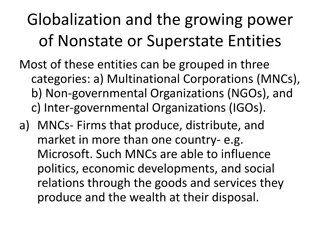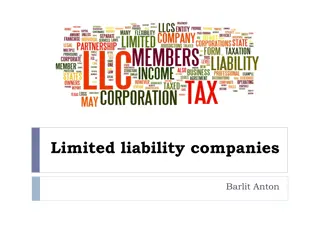Business Entities and Partnerships: Features and Types
This content delves into various business entities like sole proprietorship, partnership, co-operative society, and joint stock company. It explains the features, merits, and criteria of a sole proprietorship, as well as the types of partners in a partnership. Additionally, it covers the types of partnerships based on duration and liability, along with the essential components of a partnership deed. The discussion also touches upon the features of a co-operative society, highlighting aspects like voluntary membership, legal status, and limited liability.
Download Presentation

Please find below an Image/Link to download the presentation.
The content on the website is provided AS IS for your information and personal use only. It may not be sold, licensed, or shared on other websites without obtaining consent from the author.If you encounter any issues during the download, it is possible that the publisher has removed the file from their server.
You are allowed to download the files provided on this website for personal or commercial use, subject to the condition that they are used lawfully. All files are the property of their respective owners.
The content on the website is provided AS IS for your information and personal use only. It may not be sold, licensed, or shared on other websites without obtaining consent from the author.
E N D
Presentation Transcript
Sole Proprietorship Hindu Undivided Family(HUF) Partnership Co-operative society Joint Stock Company
Sole Proprietorship It refers to a form of business which is owned, managed and controlled by an individual who is the recipient of all profits and bearer of all risk.
Features 1. Individual ownership 2. Easy formation and closure 3. Unlimited liability 4. Sole risk bearer and profit recipient 5. Control 6. No separate entity 7. Lack of Business Continuity
Merits Quick Decision making 1. 2. Confidentiality of information 3. Ease of formation and closure 4. Direct Incentive 5. Sense of accomplishment 6. Flexibility of operation
Criteria Capital Contribution 1. 2. Participation in management 3. Share in profit and loss 4. Liability
Types Active Partner 1. 2. Sleeping Partner 3. Secret Partner 4. Nominal Partner 5. Partner by Estoppel
Types of Partnership a) On the basis of Duration -: Partnership at will 2. Particular Partnership 1. b) On the basis of Liability-: General Partnership 2. Limited Partnership 1. c) Limited Liability Partnership (LLP)
Partnership Deed Name and address of Firm Name and address of Partners Capital Contribution Profit sharing Ratio Rules to be followed in case of admission, retirement and death of a partner etc.
Features Voluntary Membership 1. 2. Legal Status 3. Limited liability 4. Democratic Control 5. Secularism 6. Service Motive 7. Finance
Advantages Ease of Formation 1. 2. Democratic Management 3. Limited Liability 4. Stable Existence 5. Economy in Operations 6. Support from Government
Limitations Limited Resources/shortage of Funds 1. 2. Inefficiency in Management 3. Lack of Secrecy 4. Government Control 5. Differences of Opinion
Types of Co-operative Societies Consumers Co-operative Societies 1. 2. Producers Co-operative Societies 3. Marketing Co-operative Societies 4. Farmers Co-operative Societies 5. Credit Co-operative Societies 6. Co-operative Housing Societies























